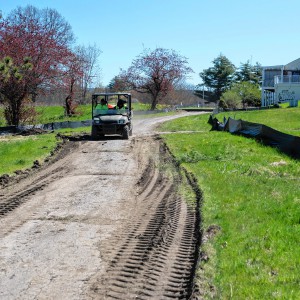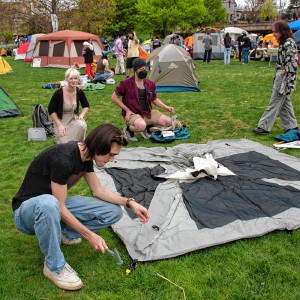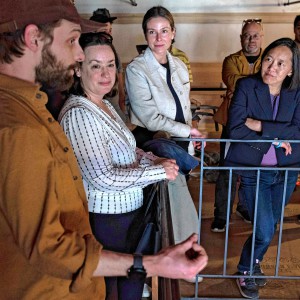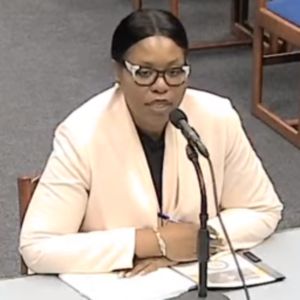Reading lessons that resonate: Easthampton schools adopt ‘science of reading’ teaching method better keyed to how brain works
| Published: 02-15-2023 5:47 PM |
EASTHAMPTON — With their backs against pillows and their outstretched legs crossed side by side on the floor, two kindergarten students read books out loud to one another in the corner of Jessica Sico’s classroom. All the while, their fingers follow along the text of each word as they read it.
In the opposite corner, paraeducator Michele Lambert works with another group of students on how to build a sentence using “who,” “what” and “where” words.
In the middle is a group of students who are applying what they have learned to color a February-themed picture.
Amid all of this activity, Sico leads another group of students to sound out letters in unison and practice sounds while watching the shape her mouth takes as she speaks.
The bustling classroom is one of several at Mountain View School tackling the district’s new approach on how to teach its youngest learners to read through the “science of reading.” The evidence-based approach helps students decode the words on a page by breaking them down into parts and understanding the sounds that letters make. The method incorporates phonics, vocabulary, comprehension and knowledge building.
As the district makes this shift, educators are moving away from a so-called “cueing” model in early reading assessment and instruction in which teachers prompt students to draw on three sources of information to identify words: meaning drawn from context or pictures, syntax, and visual information including letters or parts of words.
Five decades of research has disproved this theory of reading, said Jodi Alatalo, the Easthampton district’s literacy coordinator and instructional coach.
“The way in which we used to teach reading and the way I was always trained to teach reading was to predict what the next word would say using the first sound in the picture clue,” Alatalo said. “We have moved away from this flawed theory of reading.”
Article continues after...
Yesterday's Most Read Articles
 Pro-Palestinian protesters set up encampment at UMass flagship, joining growing national movement
Pro-Palestinian protesters set up encampment at UMass flagship, joining growing national movement
 Homeless camp in Northampton ordered to disperse
Homeless camp in Northampton ordered to disperse
 Authorities ID victim in Greenfield slaying
Authorities ID victim in Greenfield slaying
 The Iron Horse rides again: The storied Northampton club will reopen at last, May 15
The Iron Horse rides again: The storied Northampton club will reopen at last, May 15
 Filling the need: Volunteer Fair returns, giving those seeking to donate their time a chance to see what’s out there
Filling the need: Volunteer Fair returns, giving those seeking to donate their time a chance to see what’s out there
 Amherst officials outline vision for Hickory Ridge: fire station, community center, affordable housing among options
Amherst officials outline vision for Hickory Ridge: fire station, community center, affordable housing among options
Easthampton, like many districts nationwide, has moved toward a science of reading model that educators believe gives students explicit teaching of the foundational skills needed to become a better reader.
Alatalo recently gave a presentation to the Easthampton School Committee on how she is working to bring the programming to educators and learners at Mountain View School.
The brain learns to read by pairing word recognition skills and language comprehension, according to Alatalo.
“We now have a much clearer understanding of how we can teach children to read,” she said. “We are not wired to read. We are wired to speak, and so through the process of teaching children in a really explicit way how to unlock the sounds from the letters they see in print, is reading. And that is the settled science.”
Three years ago, Alatalo and several district reading specialists attended a foundational skills workshop at Bay Path University led by Joan Sedita, founder of a professional development organization called Keys to Literacy.
At that workshop, Alatalo said she learned it was clear that the city’s schools were not addressing some of those hidden skills in the way reading was taught. While at the workshop, she met prominent professionals in the literacy world, and was encouraged to pursue an advanced graduate degree.
The program covers topics such as assessment and instructional planning for students with specific learning disabilities, including dyslexia and related disorders of reading and written language, and for second language learners.
“I am almost to the end of my program. It’s a 48-credit program. It’s pretty massive, but I committed to doing that program because I felt an urgency to learn as much as I could to really shift our teaching in the right direction,” she said.
While classes in the district were still remote during the COVID-19 pandemic, Alatalo says she piloted a targeted intervention reading program in consultation with a California-based nonprofit, Center for the Collaborative Classroom, designed to help struggling K-12 readers, including English learners and students identified with dyslexia.
The intervention program — Systematic Instruction in Phonological Awareness, Phonics, and Sight Words, or SIPPS — is aligned with the district’s general education reading instruction, which serves children in kindergarten through fifth grade, and includes instruction in phonics, decodable readers, and word study, in addition to comprehension, fluency and writing.
The curriculum for SIPPS includes working with sounds, working with letters or groups of letters, and an application to decodable words and texts, and spelling.
This means that students identified under the state’s “Title 1” reading — which refers to students failing or are most at risk of failing to meet the state’s academic standard — are “getting a ‘double dose’ of structured literacy at their point of need,” Alatalo said.
SIPPS has since replaced the district’s targeted intervention Reading Recovery method, which provides one-on-one tutoring for low-achieving first-grade students.
Before 2020, Alatalo said that the district’s Title 1 teachers were only teaching four first-grade students per cycle of intervention, which is approximately 12 weeks, using the Reading Recovery method.
“Typically, they were able to work with eight to 10 students per year in total. Reading Recovery could only be delivered in a 1 to 1 model. Each daily lesson was 45 minutes. That left only two ‘small group’ blocks per day for the TItle 1 interventionists to teach students in grades 2-4,” she explained. “Often only the lowest grade two students received intervention. The others went without.”
Now, the district provides intervention with SIPPS to students in kindergarten through grade five. Alatalo said the program allows the district to teach children in groups of four to six for 30 minutes each day. Using this approach has allowed the district to take on kindergartners as well.
The district has also adapted its screening process to better determine who they need to reach. For first grade and second grade students, the district is using STAR Early Literacy’s diagnostic assessment. For third, fourth and fifth grade, the district uses STAR’s reading comprehension assessment.
The district adopted a different screening assessment for pre-K and kindergarten called the Early Bird. The state-approved literacy screener platform offers dyslexia screening to identify students at risk.
“That (screening) gives us this data that points to potential reading challenges. And because we know that systematic explicit instruction in sounds and print, matching them for children, allows for struggling readers to learn to read more successfully … we’re enabling those systems of the brain to work better,” she said.
The Massachusetts Board of Secondary and Elementary Education passed a new regulation last fall requiring all school districts to screen kindergarten through third grade students at least twice a year from a list of approved literacy screeners. This follows a law passed in 2018 requiring the Department of Elementary and Secondary Education to issue guidelines to assist school districts in developing screening procedures for students that demonstrate early signs of dyslexia.
School Committee Chairperson Cynthia Kwiecinski, who teaches special education, said she was very excited about this approach, while member Ben Hersey also voiced his enthusiasm for the approach and inquired how Alatalo would be measuring progress.
Alatalo said every child’s progress is monitored every two weeks through an assessment that will allow the district to see how students move through the program.
“By having screening in place on a regular basis, we’re able to catch students who perhaps, maybe can read, but their fluency is impaired,” she said. “For students who aren’t making progress in SIPPS, the reading specialists consult with one another and we make instructional adjustments. Sometimes those adjustments are regrouping students. Sometimes we’re adding more work with phonological or phonemic awareness. We have some other kind of informal assessments that we use to make those decisions.”
Emily Thurlow can be reached at ethurlow@gazettenet.com.
 Pro-Palestinian encampment disperses at UMass, but protests continue
Pro-Palestinian encampment disperses at UMass, but protests continue Amherst council confirms Gabriel Ting as police chief
Amherst council confirms Gabriel Ting as police chief Music key to Northampton’s downtown revival: State’s top economic development leader tours city
Music key to Northampton’s downtown revival: State’s top economic development leader tours city  Island superintendent picked to lead Amherst-Pelham region schools
Island superintendent picked to lead Amherst-Pelham region schools
